I’d been dreaming about cage diving with great white sharks off the coast of South Africa for years, so when the day finally came, my heart was already racing before I even hit the boat. Dropping into that cage and seeing these massive sharks up close was just as wild and adrenaline-pumping as I’d hoped. Watching their fins slice through the water and locking eyes with those big, black, soulless stares—it was equal parts awe-inspiring and downright terrifying.
But I also learned a few things along the way that I wish I’d known beforehand. So here’s a rundown of what the experience was like—plus some tips to help you make the most of your own shark cage dive.
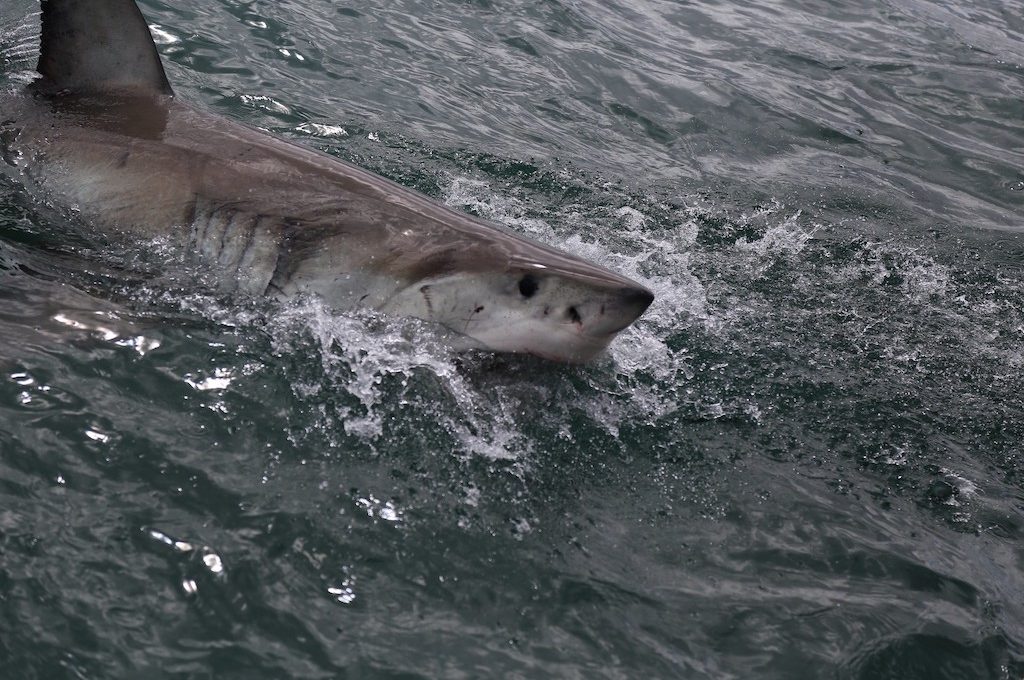
Booking
I recommend booking your dive online as early as you can. Cage diving has become a pretty popular bucket-list item in South Africa, and spots fill up fast—especially during peak season.
As soon as you know your travel dates, hop online and reserve your spot, especially if you’re going with a group. I went with Marine Dynamics and had a great experience—you can book directly through their site here (highly recommend!).
Tip: Use the free app WalletFlo to help you travel the world for free by finding the best travel credit cards and promotions!
Be as flexible as possible
The outings for the great whites can’t happen everyday due to the ever-changing conditions of the sea and weather. In fact, the tours usually cannot be confirmed until the day before the shark dive.
Thus, if you’re going to be in the area for a few days, I recommend booking your shark dive tour at the beginning of your time in South Africa and then trying to remain flexible with an alternate day or two later on in the week just in case you aren’t able to make it out to the sharks that day.
Another thing, because you’re dealing with nature there’s never a 100% guarantee that you’ll see sharks. However, the sighting rates for these tour companies are very high so the odds are usually in your favor. If you don’t see a shark, you should be able to reschedule an additional tour free of charge and if you’re not able to reschedule, they will usually refund you 50% of your fees.
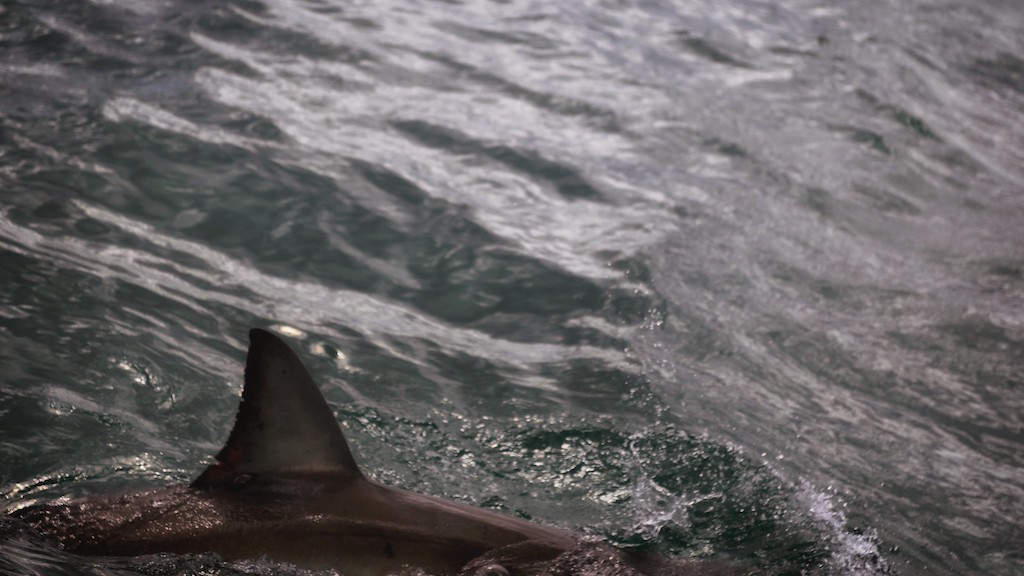
The tour
If you’re coming from Cape Town, you’ll have about a 2.5 hour one-way journey to Gansbaai, South Africa. This is a very scenic route through the hills and along part of the coast line and if you’re lucky you might even be able to do some baboon spotting.
When we did our tour we scheduled a bus-van pick up but if I could do it all over again, I may have just rented a car to go along at our own pace. It all depends on your personal preference of course, but the 2.5 hour ride will be a pleasant one regardless of how you get there.
If you go with the tour option that includes transportation, your pick-up time will vary and could be as early as 3 am or as late as noon, so again, the key is to remain as flexible as possible and to remember that even if you have to wake up at a ridiculous hour, it will all be worth it in the end.
Prepping
Once you make it to Gansbaai, you’ll meet in the The Great White House, a cozy building that acts as the headquarters for the cage diving. There, you’ll be served with real breakfast options like eggs, sausage, rolls, cereal, coffee, etc.

I recommend trying to consume as many calories as you can in the morning so that you don’t have to worry about your appetite when on board. And even if you do get a little hungry when on board, they should have chips and sandwiches to help hold you over until you make it back to land.
While you’re eating breakfast, the staff will call you down stairs and take your size needed for your wetsuits and booties and also take the payment for your tour if you haven’t already paid.
After you’re checked-in and have had a little breakfast, you’ll begin watching an introduction video that will give you some background on the sharks and safety tips and instruction for going out on your tour. You’ll also learn about some of the conservation efforts of the diving company to help preserve the sharks and their ecosystem.
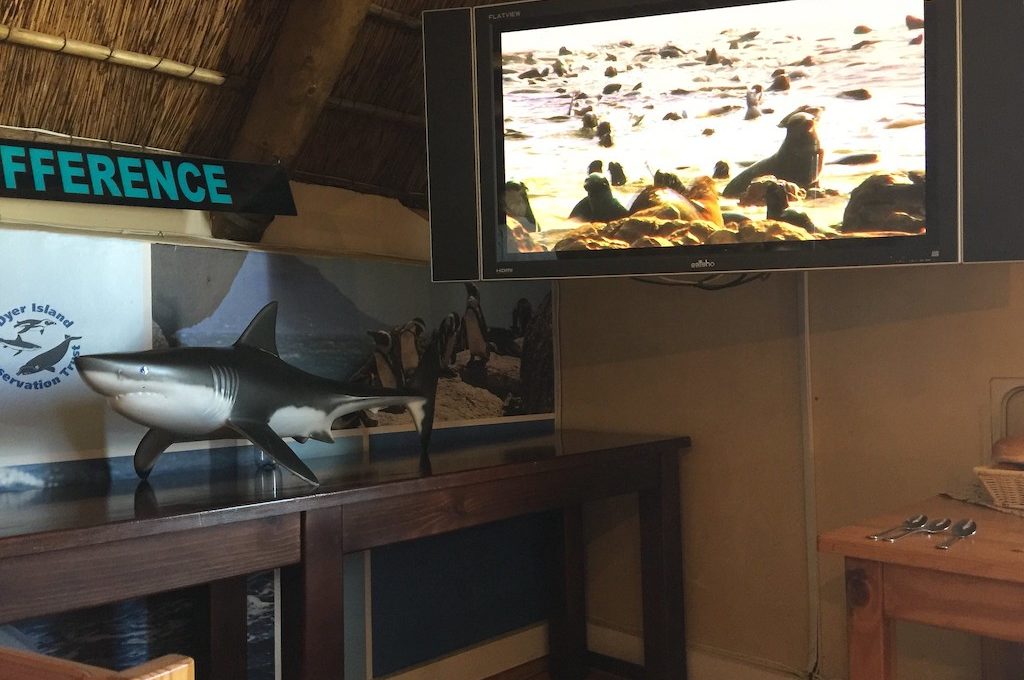
You’ll then head outside to get suited with a life jacket and a thick weatherproof orange coat that will help you from freezing when the wind picks up. If it’s windy and cold outside, this jacket will be a godsend on your way out to the sharks.
Our morning started a little cloudy and then turned into a very sunny day so we felt just fine, but I could see how on a very windy and cold winter day, you’d want to bundle up with these coats and perhaps even a beanie and a pair of gloves.
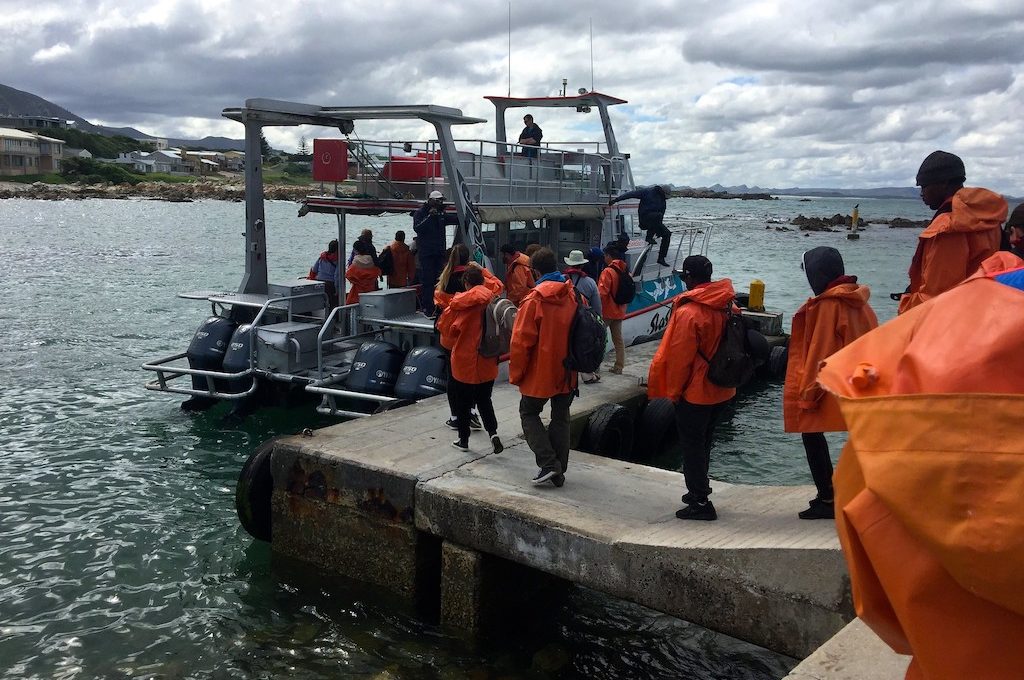
The boat we went out on was called “Slashfin,” and was “the first aluminium boat of its kind in the industry, specifically designed and built for low maintenance, stability, speed and superior safety and comfort.” It can comfortably fit up to 40 people at a time and comes with 2 toilets and an upper and lower deck.
On each deck, you’ll find seats with storage compartments underneath. There should be plenty of room to store all your belongings and keep them shut away from the elements.
The ride out to the sharks
The ride out to where the sharks linger is a short one; I believe it only took us around 15-20 minutes to make it to our “dive” spot, though that can always vary by a little. This was a huge relief since on a prior trip to whale sharks, we had about 2.5 hours of waiting time to find them!
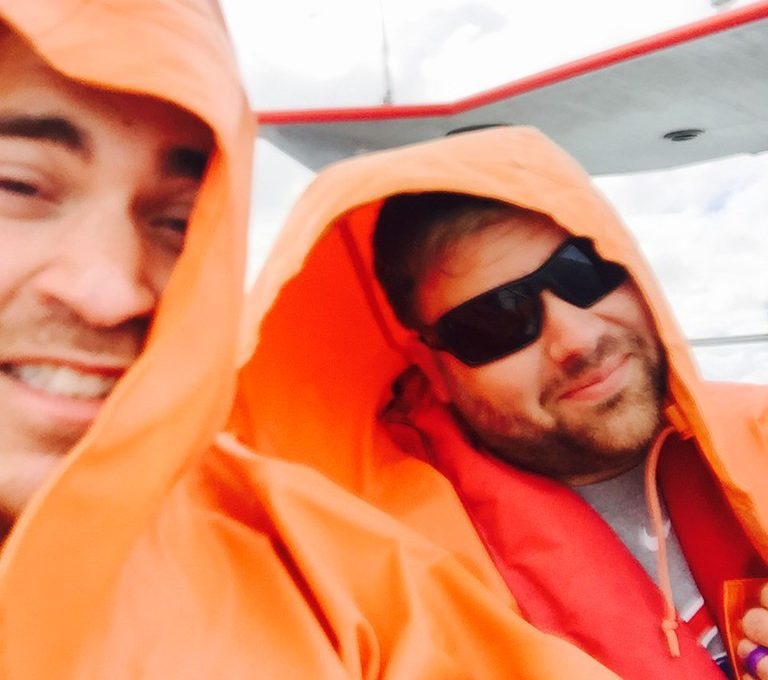
The dive spot is in shallow water probably around 30 feet, so for those of you who don’t like to venture way out into the deep sea, you don’t have anything to worry about.
Once you arrive to this spot, the staff will start handing out red bags containing your wet suits and booties. (Remember to wear your swimwear underneath your clothes.)
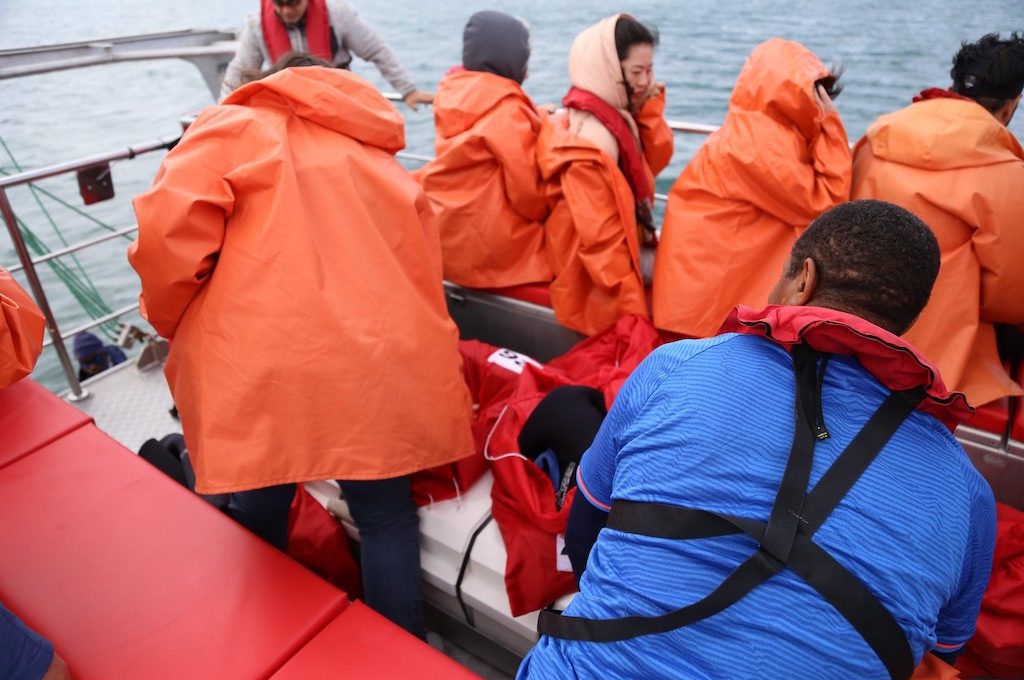
Our wetsuits and booties came dry and in great condition. The trickiest part of the trip is trying to slip on your wetsuit while the boat is rocking a bit. This was especially tough up on the top deck. Just take your time and ask for help if you need it and you’ll be in your wetsuit in to time.
The cage dive experience begins
As soon as the boat makes it to the diving spot, the staff will start assembling the cage and attaching it to the side of the boat.
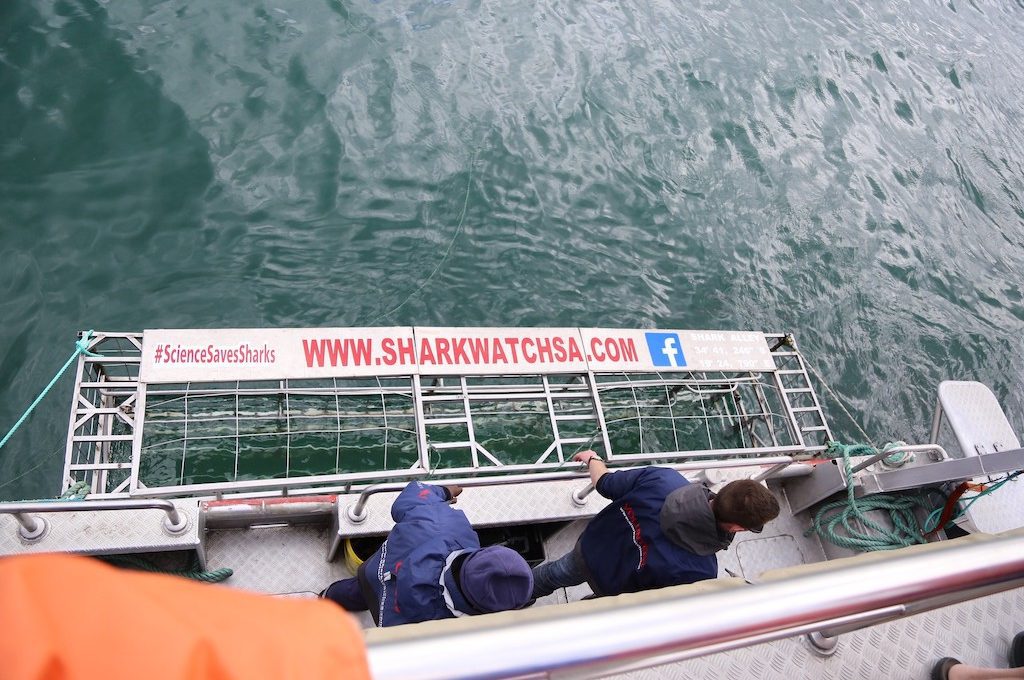
They’ll also spread chum and fish oil into the water to create a scent trail in order to attract the sharks.

We were assured that based on current research, these methods do not have a deleterious effect on the sharks and merely act as an enticement for them, much like smelling a good meal would be for us humans.
Once the chum is out and the fish oil poured, you’ll hopefully begin to start getting your first shark sightings!

As the sharks start showing up, they start instructing people to get into the cage. Right before you enter, they’ll fit you with goggles (no snorkel needed) and a weight belt that goes around your shoulder and you’ll queue up to get in.
There didn’t seem to be any predetermined order of who goes in first but my advice is to try to be in one of the first couple of groups since it seems like the later groups didn’t receive as much interest from the sharks. Some of that may just come down to luck but I think it makes sense that some of the sharks only linger around for a short while until they figure out there’s really nothing for them.
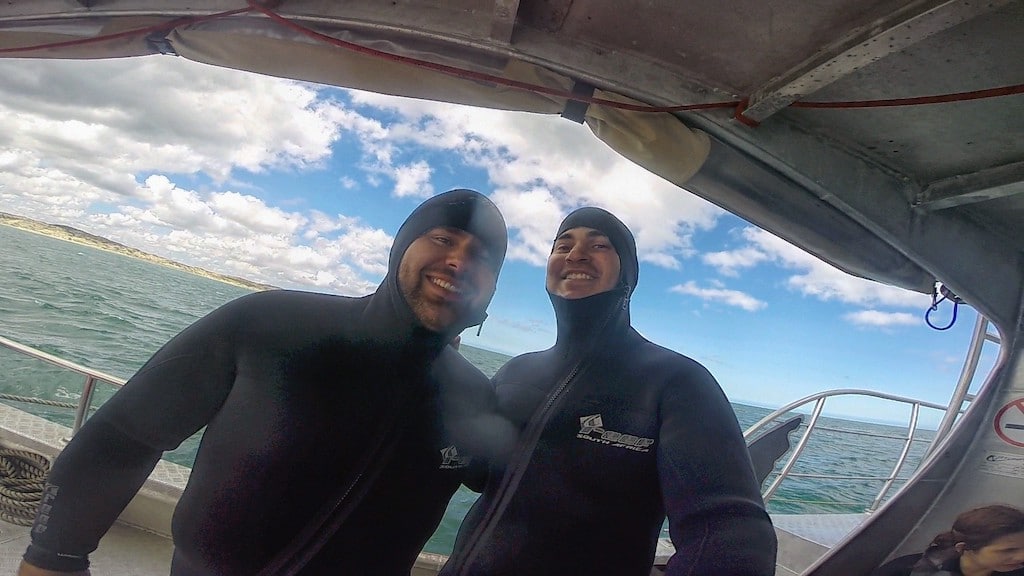
The cage fits about eight people. To get in, they’ll open up the top latch and then have you climb down the interior side of the cage like a ladder. The first one in goes to the opposite end and then every one else falls in behind, forming a line along the cage.

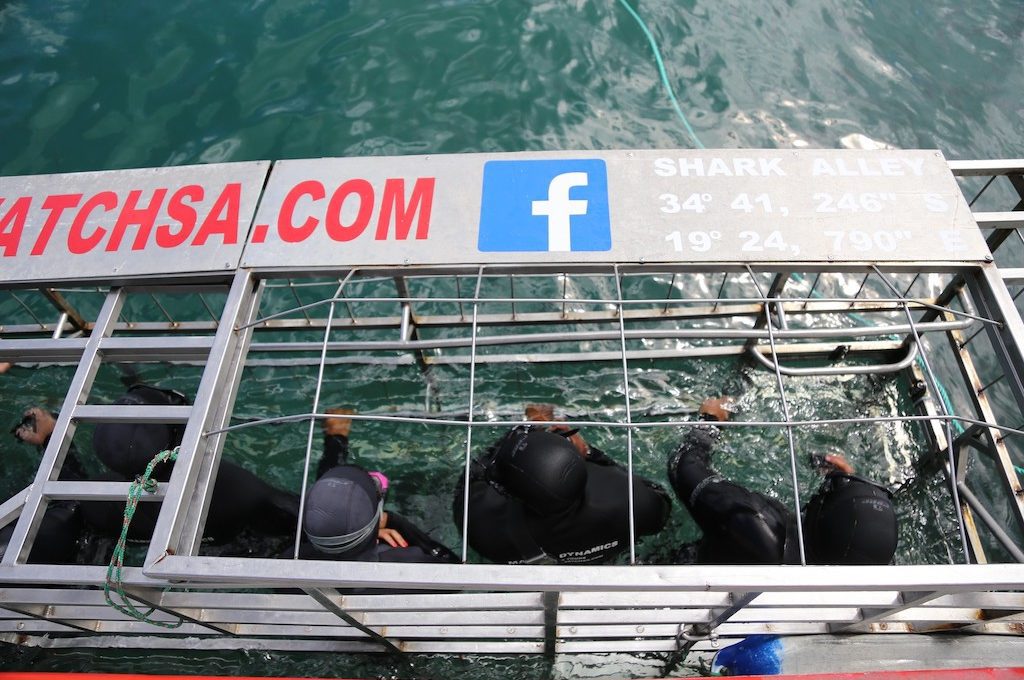
In the cage there are multiple bars for you to grasp (on the inside of the cage) with your hands and to help keep yourself underwater with your feet. You’ll be bobbing around in the cage regardless of what position you take, but the bars will help you stabilize so it’s not that bad.
With eight people in the cage, it does feel a bit crammed but not to the point where it feels unsafe or threatening. And of course, you want to keep your hands and feet inside the cage at all times.
Water temperature
The water can range from 12º C/53º F and 20º C/70ºF. Obviously in the winter the water will be its chilliest and during our visit in late winter, the water was hovering around 16º C/61º F.
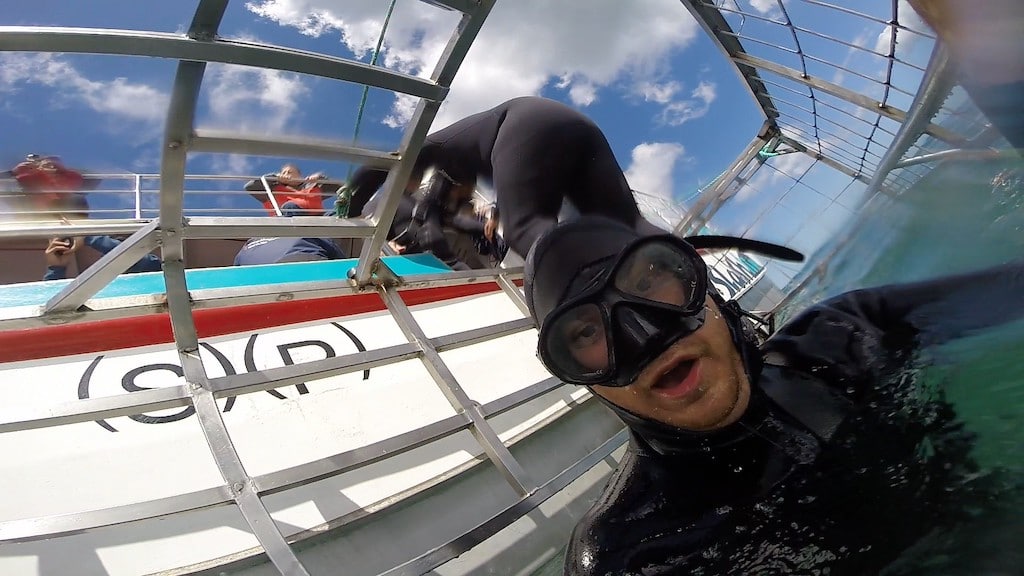
However, with the wet suit they provide you (complete with hood and booties), your body quickly warms up and the temperature of the water is not really an issue, especially once the sharks start showing up and you’re not even thinking about the cold. If you’re very sensitive to cold temperatures, however, you may want to get out a little early, which is fine. The staff is willing to help anyone out of the cage at any time if they want to get out.
Visibility
The murkiness of what water depends on a lot of different factors, such as the winds, currents, tide, and so forth. The staff will be able to tell you what kind of visibility will be expected for that day on the day of your dive, but I don’t think there’s any way to predict it ahead of time. On average visibility can be between 6 – 8 m, but “it can go up to 12 – 15 m on a good day and down to 1 – 3 m on a bad day.”

On our outing, visibility was about 1.5 meters, so we caught in on a “bad day,” but our experience was still fantastic. If you catch it on a day like ours, this means that you won’t be able to see the sharks coming in from a far distance.
Instead, you’ll rely on the spotters on board to know when to dunk yourself and where to look for the sharks coming in. Once the sharks do get within range, you have great views of them and the murkiness isn’t really an issue.
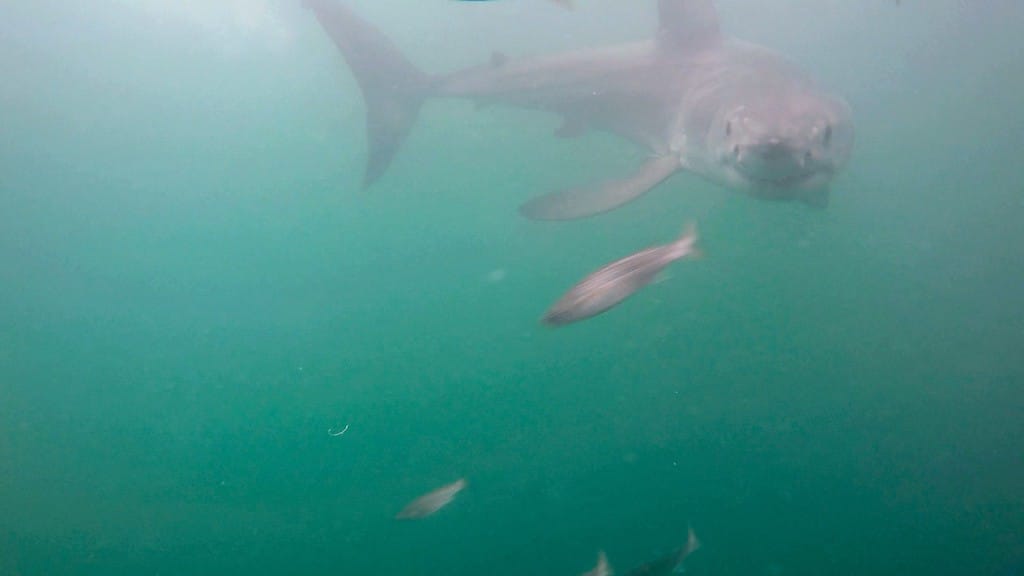
The cage dive experience
Once you’re in the cage keep your ears open for the instruction of the spotters will direct you where to look in order to find the sharks.

There are two people on board who throw out items to lure the sharks. One person throws out a seal decoy on one side of the cage and the other person throws out a ball of dead fish. They are thrown out on either side of the cage so that they can lure the sharks from either direction, allowing for divers on both sides of the cage to get great views of the sharks.

Once you’re in the cage, the bait handlers and spotters will tell you to look left, right, or in front. Once you hear that you submerge yourself into the water and look in that direction. Chances are that within a couple of seconds, you’ll see a shark heading your way. (One way to know if a shark is coming is if the the hundreds of fish swimming nearby disperse in an instant.)
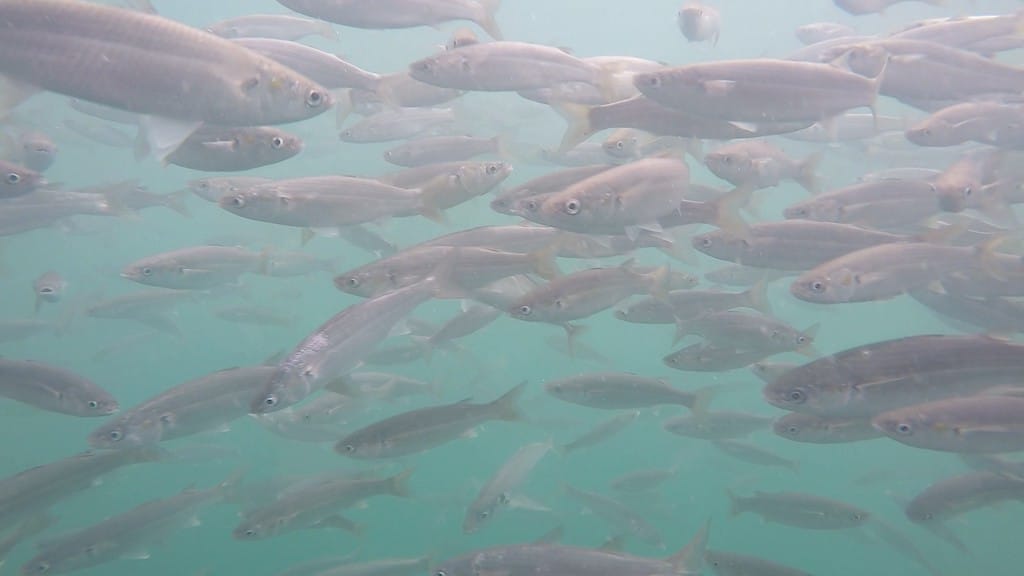
Sometimes the sharks veer away quickly and you never see anything more than a fin or tail but sometimes they hang around making a few spectacular lunges for the bait.

And sometimes, they come into contact with the cage and almost swallow your GoPro as you can see in my video below!
There’s no telling how many different sharks may come around but our instructors spotted a total of 5 or 6 different sharks (we also were greeted by two giant stingrays!).
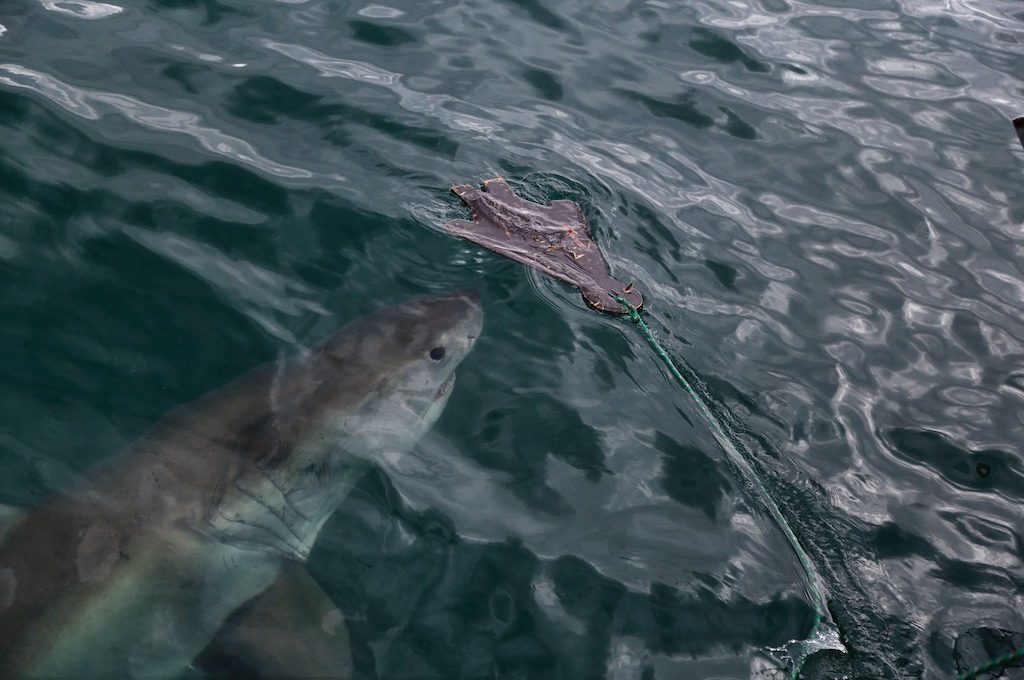
A couple of the sharks are common guests, like Scarlett, a beautiful great white who spent a lot of time hanging out around the cage.
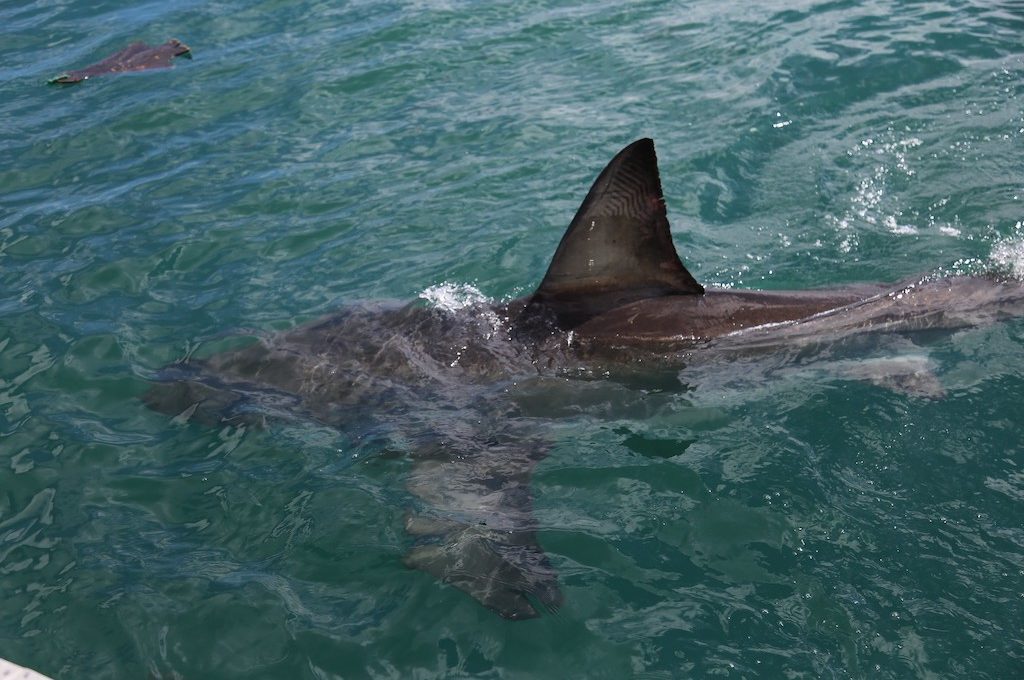
The sharks are fast…
When the sharks are just investigating what’s going on at the surface they just sort of mosey around and it’s easy to spot them and observe them, but when they decide to go for the decoy or the bait, they are very fast. So whether you are on the boat above or in the water below, keep your eyes open and be ready for it because the action happens very quickly sometimes.

There’s no strict time limit for how long you’re allowed to be in the cage. The goal of the staff is to allow everyone to have the same experience with the sharks so one group may see 5 sharks in 10 minutes while another group sees 5 sharks in 30 minutes. It all varies but you can be assured that the staff is doing their best to attract the sharks for you.
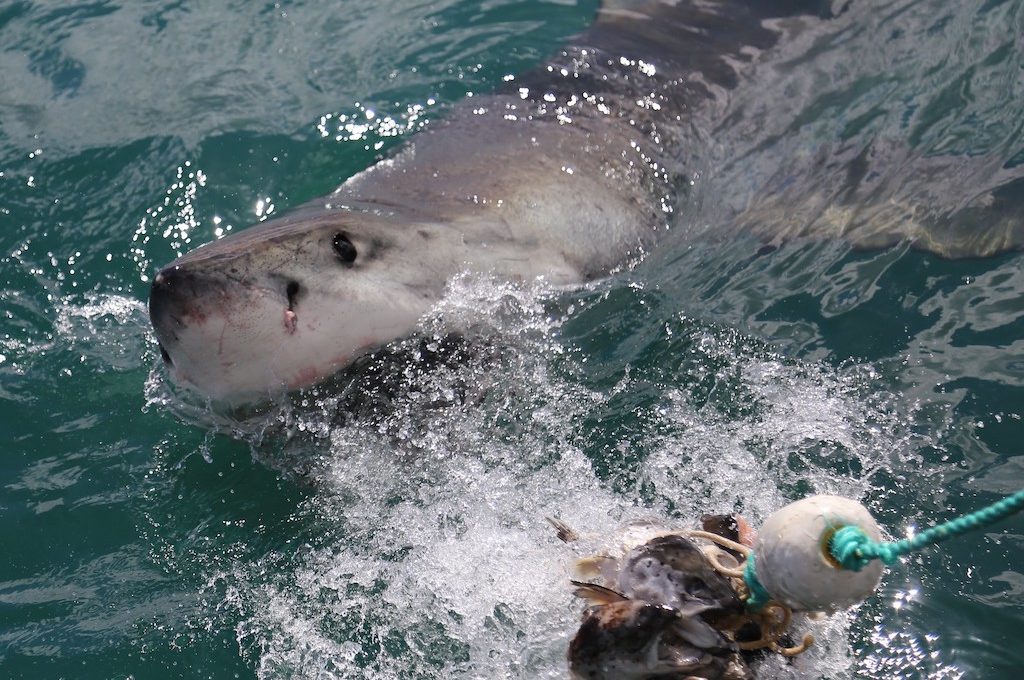
One thing that the staff will tell you to do in order to encourage the sharks to visit you while you are in the cage is to make seal noises! At first I was sure it was a joke but apparently it works. You submerge yourself underwater and make “bahhh” noises like sheep. This apparently sounds like a seal underwater and helps to attract the sharks and is worth a try if you’re not seeing any sharks.

Tips for photographing or taking video
Photographing or video recording these sharks can be tricky so here are some tips.
Inside the cage
The first tip is for when you’re in the cage. When you’re in the cage, I suggest trying to get one of the ends of the cage, preferably the side where the ball of dead fish gets thrown. Yes, it means you’ll be the closest to that ball of dead fish, but it will probably give you the best chance of getting close to a great white, since they tend to go for the fish a lot and will often whip around the side of the cage, right next to where you’ll be.
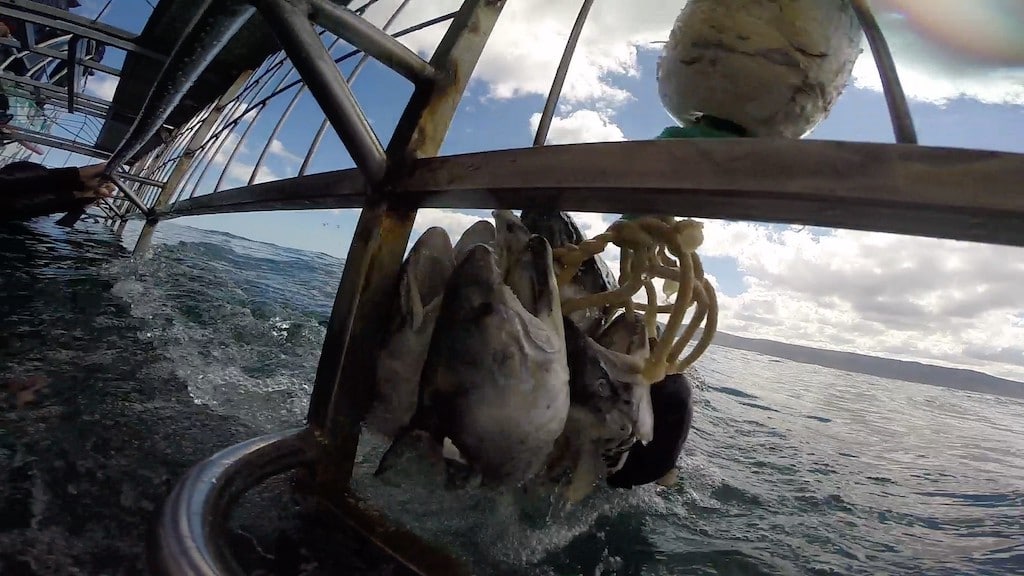
I personally would just go with a GoPro or other video camera and then pull still images from that later on. Based on my prior experiences, taking still photographs in murky water with a lot of thrashing hardly ever turns out well.
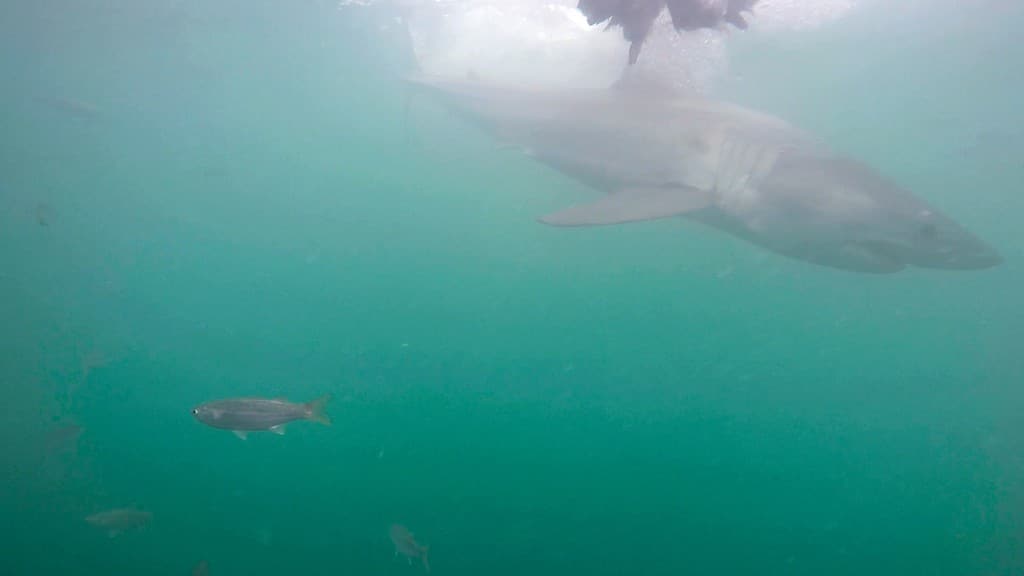
I also suggest trying to record a few feet under the water’s surface. The reason is that if you place your camera right at or under the water’s surface, there’s a good chance that the splashing from the shark or bait will ruin your shot. But if you’re under the water, these things won’t affect you as much.

That doesn’t mean you need to keep your camera submerged the whole time. Sometimes you might be able to follow a shark up out of the water and get an amazing up close shot of its “jaws” lunging for bait. That’s probably going to require more luck than anything, though, since the sharks are so quick and you never know how they’re going to react. So if you go with that technique I’d use it sparingly.
Outside the cage
If you’re not in the cage the best place to take photographs of the sharks is on the boat next to the handlers throwing out the decoys and the bait on the bottom deck. They will lure the sharks toward you and you can use their spotting abilities to help you spot the shark.

If you want to photograph an awesome “Jaws” like shot then you need to just start firing your shutter as soon as they spot the shark and you can make out its silhouette.
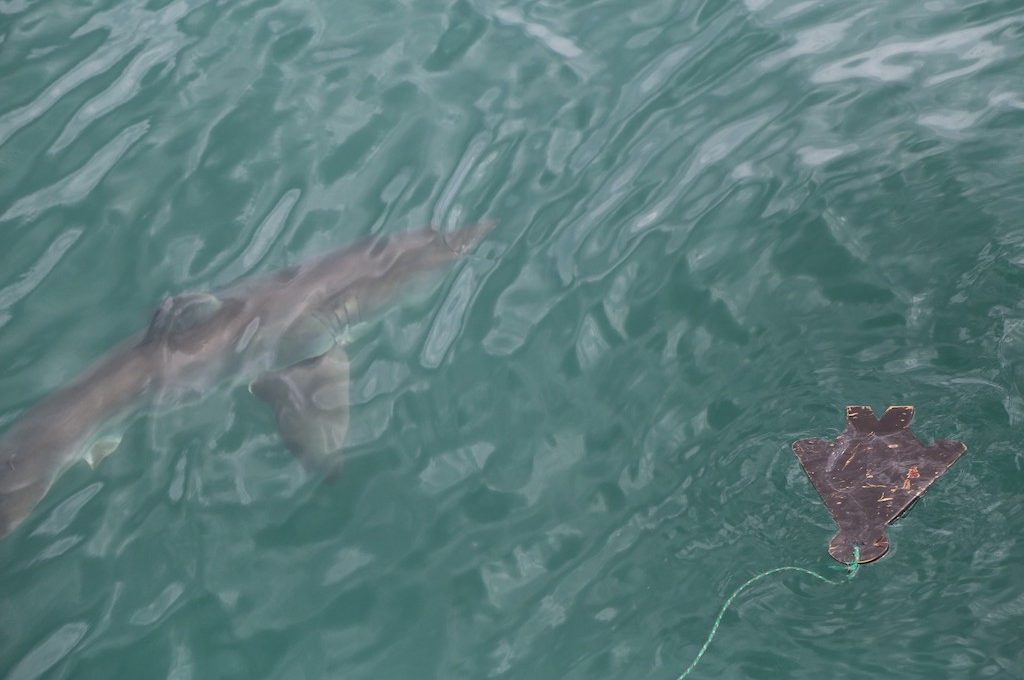
Just keep taking photographs, following the sharks movement and if and when it does decide to lunge out of the water, you’ll have a good chance of capturing its powerful jaws opening up.
Otherwise, if you don’t anticipate its movements, it will be next to impossible to photograph the shark before it goes back under and you’ll probably not be able to photograph its face/jaws.
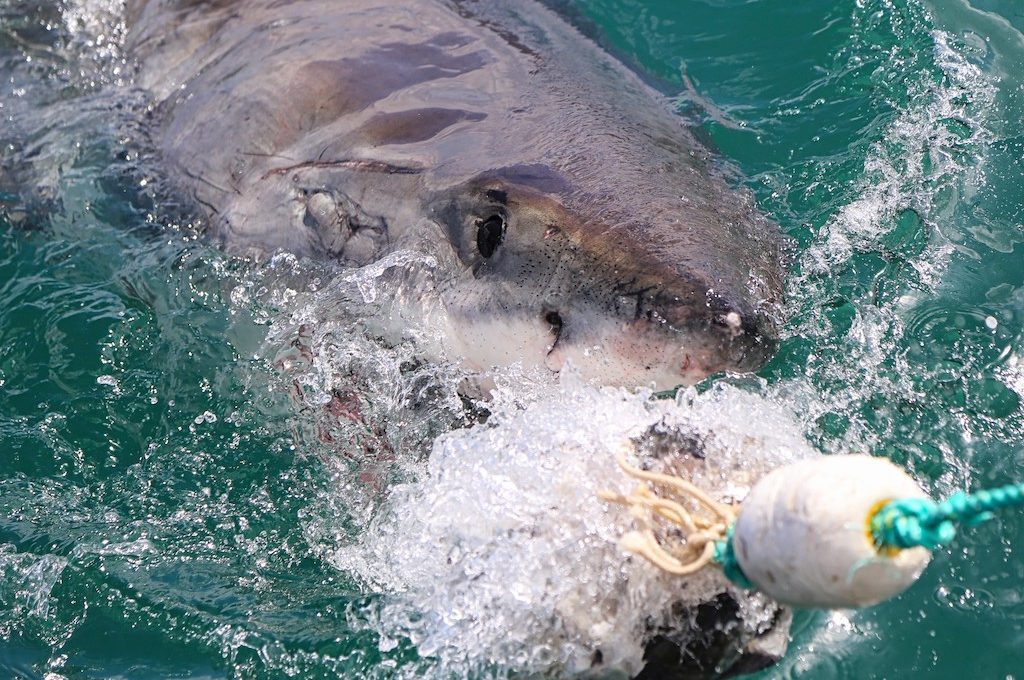
The view from the top deck of the boat is great as well. However, you’ll need a camera with a very powerful zoom and fast telephoto lens (200m plus) to get great close ups. While you can spot the sharks from the top deck easier, I still think that if you want to get an awesome close up of a shark, you should stick to the lower deck. It will also be easier to get shots of the shark lunging from the water since you’ll be close to eye/mouth level with the shark.

Getting out of the cage
After you come out of the cage they provide you with hot chocolate and a sandwich and chips pack. At that time you’ll be able to change out of your wet suit and back into your dry clothes, unless you’re part of the last group. In that case, you’ll probably have to just wait the 15 or 20 minutes it takes to get back to the dock.
Debriefing
When you arrive back to the dock, you’ll head back to The Great White House. There, you can pay a few bucks to take a shower in some make-shift showers and always get something to eat. When we arrived back they served us some nice warm soup and then played us a video of our experience that they had quickly put together. This is also your chance to participate in one of their programs where you can help with their conservation efforts, so I suggest devoting a little bit of time to hearing them out.
Final word
Very few things can compare to the adrenaline rush of coming face to face with a massive great white underwater and this is an experience that only a very small number of places around the world can offer you. It’s estimated that around 2/5 of the world’s great whites inhabit these waters so it’s a special place to view them.
This activity can suit people of all ages and all it takes is a little sense of adventure and you’re good to go. If you’re in the Cape Town area, then you owe it to yourself to at least entertain the idea of getting into the ocean with great whites — you won’t regret it!
Daniel Gillaspia is the Founder of UponArriving.com and the credit card app, WalletFlo. He is a former attorney turned travel expert covering destinations along with TSA, airline, and hotel policies. Since 2014, his content has been featured in publications such as National Geographic, Smithsonian Magazine, and CNBC. Read my bio.

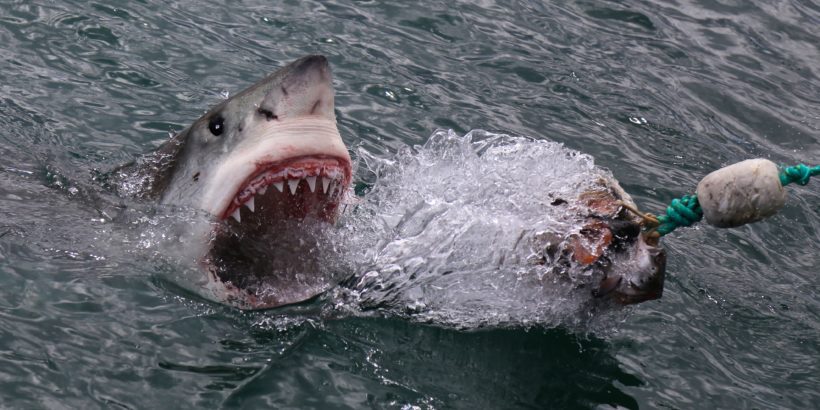

I went shark cage diving in Gansbaai in April. I used Great White Shark Tours (top Tripadvisor rated) which seemed equally good. I would recommend NOT eating breakfast right before boarding, the constant swaying of the boat had a large number of passengers feeling very nauseous. Specially if you were on the lower deck. Once in the water, the cold temp made the nausea better, though the tuna bait being thrown in front of us made me dry heave. As soon as we returned to shore the nauseous feeling disappeared and we were able to eat lunch which was offered by our tour company. This is a must do activity. You won’t regret it.